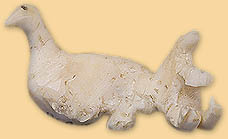 |
John Foster Caldwell was assigned to the Hudson's Bay Company (HBC)
post at Fort Chimo, Ungava Bay in 1913. He was later transferred to
take charge of the HBC post at George River. Caldwell was in Northern
Quebec from 1913 through to 1916.
His collection at the Canadian Museum of Civilization consists of
four walrus tusks, carved in the round. One is signed Fort Chimo, 1914,
which is probably the date and provenance for all four pieces. It appears
that tusks carved as composite images were a specialty of the Ungava Bay
area. Frank Speck, the American anthropologist at the National Museum of
the American Indian, discusses very similar pieces that their museum
obtained during the 1920s, also from the Ungava Bay area.*
*Frank Speck
1927 – "Eskimo Carved Ivories from Northern Labrador."
Indian Notes,
vol. 4, # 4, pp. 309-314.

 |
Bird and Bear, 1914
Kuujjuaq (Fort Chimo), Nunavik
Ivory, black colouring
3.2 x 4.4 x 1.1 cm
CMC IV-B-1746
Collected by Foster Caldwell while working at the Hudson's Bay trading
post in Fort Chimo
|
 |
Caldwell, in his letters to family in Ireland, only once makes a
brief reference to carvings: "There is an old half-breed here who
carves ivory."* It can be assumed that all four pieces in the CMC
collection were created by this person. Here a large bird has
been attached to a small bear at an angle.
Although the carver had only a tiny piece of ivory to work with, he
stayed within the local tradition of carving composite pieces.
* Caldwell in his letter to North Ireland, August 1913
(National Archives of Canada, Accession # 1975-092).
Carved Ivory Tusk, 1914
Kuujjuaq (Fort Chimo), Nunavik
Ivory, black colouring
3.1 x 25.2 x 1.9 cm
CMC IV-B-1744
Collected by Foster Caldwell while working at the Hudson's Bay trading
post in Fort Chimo
|
 |
Animals from the land, air and sea are intertwined in this intricate
piece. Both the owl and the seal have black dots, most likely to indicate
markings on their bodies, as in the case of the snowy owl and the ringed
seal. The style of "deep carving" animals around a walrus tusk
is reminiscent of similar tusks from Alaska's Nunivak Island.*
*University of Alaska Museum
1982 – Setting it Free: An exhibition of modern Alaska Eskimo
Ivory Carving. Fairbanks: University of Alaska Museum.
p. 32, ill.#50.
Exhibition History:
A Gift to the Nation. Canadian Museum of Civilization, Gatineau,
Quebec. Mall case in the First Peoples Hall. October 2001 to present.
Arctic Mirror. Canadian Museum of Civilization, Hull, Quebec.
January 25 – September 9, 1990.
Carved Ivory Tusk, 1914
Fort Chimo, Nunavik
Ivory, black colouring
3.1 x 20.2 x 3.2 cm
Signed: Fort Chimo 1914
CMC IV-B-1743
Collected by Foster Caldwell while working at the Hudson's Bay
trading post in Fort Chimo
|
 |
The place name and date in brown ink were most likely inscribed
on to the piece by Caldwell himself. The tusk, to be held and turned
around, shows a walrus, a seal, a fish, and a small boat.
Bird, Bear, Walrus and Hare, 1914
Fort Chimo, Nunavik
Ivory, black colouring
3.2 x 6.1 x 0.8 cm
CMC IV-B-1745
Collected by Foster Caldwell while working at the Hudson's Bay
trading post in Fort Chimo
|
 |
A left-over piece of ivory allowed for only one good side in this
small composition. The four animals – a bird, a bear, an animal
standing on its hind legs, and a walrus – are not enmeshed.
Originally, the carver may have planned to break up the piece into
four separate little figures.
|